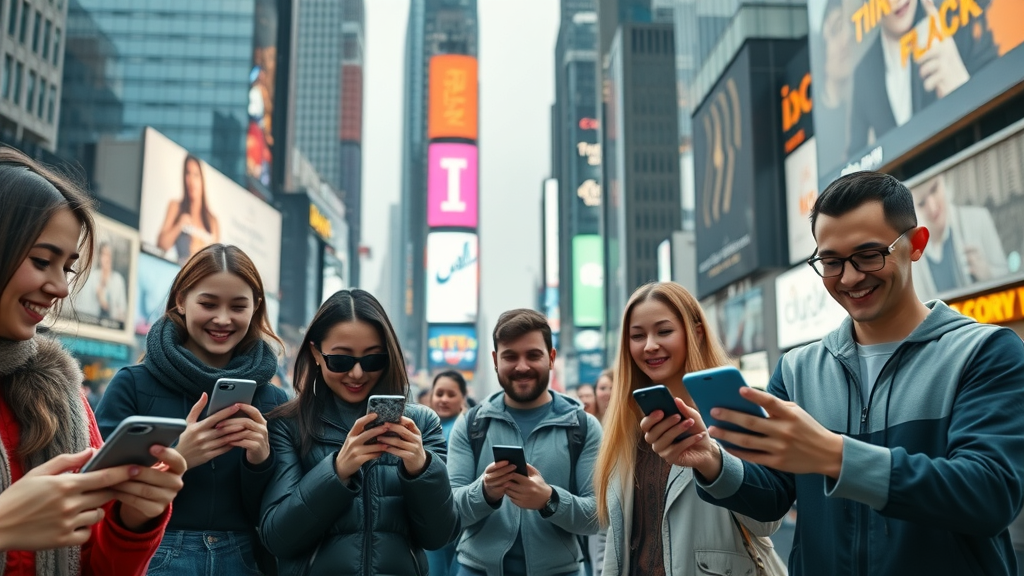Revealing the Power of Media Channel Definition in our Digital AgeDid you know that over 80% of consumers engage with at least three different media channels each day? Media channels are influencing how we consume, share, and interpret information in real-time.Discover why understanding the media channel definition is essential for mastering modern communication, marketing, and engagement strategies.Key Takeaways from This Guide: Understanding Media Channel DefinitionsComprehensive insight into the media channel definition, including traditional, digital, and social media channels.Breakdown of media channels into key types and categories.Comparison of digital and traditional media channels, plus future trends.What is the Media Channel Definition? Core Concepts ExplainedDefining a Media Channel: Meaning and ImportanceMedia channels are the highways of communication—they move messages from creators to audiences. At its heart, the media channel definition is simple: it’s any platform, method, or tool that distributes content, whether news stories, commercials, or user-generated videos. Think of a media channel as the bridge connecting you and the information you seek or share each day.The importance of a media channel has exploded in recent years, fueled by advances in digital media channels and social platforms. Today, a media channel can be a radio station , your favorite social media platform, print media outlets, or the websites you visit. Each format plays a unique role in brand awareness, content distribution, and shaping public opinion.Understanding the media channel definition is critical for businesses and communicators. Selecting the right media channels boosts reach, sharpens your message, and helps you engage your target audience—whether through print ads , a connected TV spot, or a viral tweet. With so much competition for attention, knowing how to navigate these channels is paramount.Historical Evolution of Media ChannelsThe history of media channels is a journey from ink on paper to interactive global networks. In the early days, print media like newspapers and magazines were the main channels, reaching millions of readers. Radio and television soon followed, adding sound and motion to the communication mix and influencing how the masses received news and entertainment.By the late twentieth century, the emergence of the internet revolutionized the media channel landscape. Digital media channels —from email and websites to the explosion of social media platforms —began changing how rapidly information travels and how users interact. Today, a blend of traditional and digital approaches makes up the modern media platform ecosystem, reflecting shifts in technology and audience behaviors.In the words of a communications scholar, "A media channel is any platform or method used to communicate information to a broad audience." This understanding guides organizations as they navigate the crowded world of media channels and platforms , both old and new.People Also Ask: What is the definition of a media channel?A media channel is a conduit or medium used to deliver information, advertisements, or content from a sender to a receiver, including digital platforms, print, television, radio, and online spaces.People Also Ask: What are the three main types of media channels?The three main types of media channels are traditional media channels (print, radio, TV), digital media channels (websites, email, apps), and social media channels (Facebook, Twitter, Instagram).People Also Ask: Is TV a media channel?Yes, TV is a traditional media channel widely used for distributing content to large audiences.People Also Ask: What is the role of the media channel?The primary role of a media channel is to facilitate communication between content creators and consumers by delivering messages effectively and efficiently.Types of Media Channels: An In-Depth BreakdownOverview of Media Channels Include Traditional, Digital, and Hybrid FormsThe variety of media channels is vast, and understanding each type is crucial in today’s communication environment. Traditional channels such as print media , television, and radio are well-established and continue to reach broad audiences, despite the surge of newer options. Digital media channels —including websites, apps, and search engines —offer interactivity, instant feedback, and global reach, making them favorites in digital marketing.Hybrid media platforms combine old and new elements. For example, a magazine with both print and online editions, or television broadcasts that also stream live on mobile apps. Each media channel has its own strengths and weaknesses, and successful communicators blend types for maximum impact.As we explore further, you’ll see how these media platforms and channels specialize in distinct audience experiences—vital for effective marketing strategy , brand awareness , and targeted communication.Comparison of Key Media Channel Types: Features, Reach, and ApplicationsMedia Channel TypeKey FeaturesTypical ReachCommon ApplicationsPrint Media (Newspapers, Magazines)Credible, local/regional targeting, physical presenceBroad, but limited to distributionNews coverage, public relations, advertisingTelevisionAudio/visual impact, mass reach, scheduled contentVery broad, cross-demographicBrand campaigns, public service announcementsRadioAudio only, local/national range, real-time updatesBroad, commuters/local audiencesMusic, talk shows, local news, adsDigital Media (Websites, Apps, Search Engines)On-demand, analytics, global interactivityPotentially global & highly targetedSEO, blogs, email marketing, interactive adsSocial Media PlatformsReal-time sharing, viral potential, engagement toolsGlobal, especially youth/digital nativesCommunity building, influencer marketing, feedbackOutdoor (Billboards)High visibility, long dwell time, location-basedLocal/high-traffic zonesAwareness campaigns, event promotionTraditional Media Channels Versus Digital Media ChannelsTraditional media channels remain powerhouses in media—think print (newspapers, magazines), broadcast TV , radio, and outdoor billboards. These have a track record for building wide brand awareness and reaching audiences not as active online. However, their controls are often one-way, with limited space for direct feedback and interactivity.Print (Newspapers, Magazines), Television, Radio, Outdoor (Billboard)Digital media channels have redefined communication. Channels like websites , email marketing , SEO , mobile apps , and social media platforms let marketers fine-tune reach, personalize messages, and track performance with analytics. These channels are interactive, quick, and adaptive—ideal for dynamic marketing campaigns in a digital world.Websites, Email, SEO, Apps, Social Media Platforms"Digital media is reshaping the landscape of modern communication, making media channels more interactive and accessible than ever before."The Rise of Digital Media Channels and Their ImpactUnderstanding Digital Media and Digital Marketing StrategiesDigital media channels have become essential tools for reaching audiences in the modern marketing landscape. From search engines to social platforms and streaming services, digital media offers instant connection, precise targeting, and real-time analytics. Companies leverage these digital platforms to optimize their marketing efforts and increase engagement through measurable campaigns.Strategic digital marketing goes beyond just being online. It combines content creation, social engagement, email marketing , and search engine optimization to build a strong presence across the best digital channels for a target audience. Brands achieve higher ROI when their media channel choices align with where and how people interact online.Ultimately, understanding digital media channel definition empowers marketers to allocate budgets smartly, select the right platforms for their message, and pivot quickly as consumer behaviors evolve.Popular Digital Media Channels: Social Media Platforms and BeyondSocial media giants like Facebook, Instagram, Twitter, and LinkedIn are household names in the world of digital media channels. These platforms enable rapid sharing, immediate feedback, and viral reach—transforming the way messages are distributed and consumed. Marketers favor social media platforms to spark trends, build communities, and directly address their audiences with targeted campaigns.Beyond social, digital media channels include high-traffic websites, video streaming services, apps, and email marketing tools. Each of these channels offers unique opportunities to match content with context, inviting users to interact, share, and respond in real-time—something traditional channels simply cannot match.The constant innovation across digital media channels promises new frontiers for content engagement, whether through AI-powered personalization, live streaming, or immersive brand experiences tailored to specific user preferences.Exploring Social Media Platforms as Modern Media ChannelsKey Features of Effective Social Media ChannelsTo maximize results, understanding the features of effective social media platforms as media channels is crucial. Engagement is king—platforms like Instagram, TikTok, and Twitter boost brand visibility through shares, likes, and comments. Targeted reach ensures messages are delivered to the right demographics, capitalizing on detailed audience analytics.Engagement, Targeted Reach, Analytics, Virality PotentialData-driven analytics and robust feedback tools make these channels especially powerful for marketing teams. The virality potential of social media allows a single post to reach millions around the world within hours, far outpacing traditional channels like print or radio.In an era where brand awareness and authenticity matter, social media platforms also facilitate two-way dialogues, influencer collaborations, and community-driven content, placing them at the heart of modern communication strategies.Media Channel Definition and Its Role in Marketing EffortsHow Media Channel Choices Influence Marketing StrategiesMarketing campaigns live and die by media channel definition. Choosing the right mix of media channels —blending paid, owned, and earned media—amplifies message reach and effectiveness. Paid channels drive quick exposure, owned channels (like brand websites) provide control, and earned media (like press or viral posts) add trust and credibility.Blending paid, owned, and earned channels for optimal impactA successful marketing team assesses which media channels align with their goals, audience preferences, and content type. For some, TV and billboards remain effective for mass campaigns. For others, a targeted digital strategy using email, SEO, or influencer promotions achieves greater ROI."The right media channel definition empowers marketers to connect meaningfully with consumers across multiple touchpoints."How to Select the Best Media Channel or Media PlatformCriteria for Evaluating Media Platforms and ChannelsWhen choosing a media channel or media platform , there are key criteria to consider. Understand your audience demographics : Are they teens on Snapchat or professionals on LinkedIn? Next, think about cost—does your budget suit TV ads, print media , or cost-effective digital campaigns?Audience Demographics, Cost, Message Type, Content AdaptabilityAnother vital element is the message type. Is your information best delivered visually, audibly, or in written form? Content adaptability across platforms matters, too—can your video also be shared as a GIF, or your article repurposed for email? The best media channels let you meet audiences where they are, in the format they prefer.Savvy marketers weigh these factors carefully, using analytics to continuously update their media channel strategy. The result: more effective messaging and a deeper connection with the target audience.Common Example Media Channels Include: A Helpful ListPrint (newspaper, magazines), Broadcast (TV, radio), Outdoor (billboards), Digital (websites, blogs), Social (Facebook, Twitter, Instagram)Media Channel Trends and the Future of Digital Media ChannelsEmerging Trends in Media ChannelsTechnology continues to push media channel definition to new heights. Today’s trends include personalization through AI —platforms now use artificial intelligence to recommend content that fits users’ interests. Interactive content , such as polls, quizzes, and AR experiences, deepens engagement beyond passive consumption.Personalization through AI, Interactive Content, Omnichannel ExperiencesAnother major trend is omnichannel experiences. Modern consumers interact with brands across multiple media platforms —starting on social media, then viewing an ad on connected TV, then buying through a website. Consistency across all these channels strengthens brand identity and message retention.As one industry expert observes: "Media channels will continue to evolve as technology advances, demanding a constantly updated understanding of media channel definition." Staying informed and adaptable ensures ongoing marketing success and relevance.Frequently Asked Questions on Media Channel DefinitionWhat makes a media channel effective? An effective media channel is one that reaches the intended target audience, delivers the message clearly, and prompts action or engagement. It should align with the goals of the campaign—whether raising brand awareness, driving sales, or fostering community—and allow for measurement and feedback.How do digital media channels differ from traditional media? Digital media channels are interactive, data-driven, and easily measurable, offering global reach with tailored messaging. Traditional media relies on one-way communication and is often less trackable, but it still offers strong credibility and mass-market access, especially for certain demographics.Can a single media channel fulfill all marketing needs? Rarely. Most successful marketing strategies blend multiple media channels—mixing print, digital, social, and outdoor—to capture a wider audience and reinforce messages across touchpoints. Each channel has unique strengths, and using several increases overall impact.How have social media platforms expanded media channel definitions? Social media platforms have expanded the media channel definition by introducing two-way, real-time communication. They enable direct dialogue, rapid feedback, viral sharing, and personalized targeting, evolving the role of channels from one-way broadcasters to interactive hubs.Summary: The Critical Role of Media Channel Definition TodayMastering the media channel definition is vital for anyone involved in communication, marketing, or business strategy. By understanding the various types of media channels and how to leverage them, you can ensure your messages are seen and heard in an increasingly crowded digital world.Understanding the concept of a media channel is fundamental in today’s communication landscape. A media channel refers to the specific medium through which content is delivered to an audience, encompassing platforms like television, radio, print publications, websites, and social media platforms. ( activecampaign.com ) These channels serve as conduits for information, news, entertainment, education, and promotional messages, facilitating the connection between content creators and consumers.Media channels are typically categorized into traditional and digital forms. Traditional media channels include print media (such as newspapers and magazines), broadcast media (like television and radio), and outdoor advertising (such as billboards). Digital media channels encompass websites, social media platforms, email, and mobile applications. ( sendpulse.com ) Each type offers unique advantages and plays a distinct role in reaching and engaging target audiences.Selecting the appropriate media channel is crucial for effective communication and marketing strategies. Factors to consider include the target audience’s preferences, the nature of the message, budget constraints, and the desired level of engagement. For instance, television advertising may be suitable for broad audience reach, while social media platforms can offer more targeted and interactive engagement. ( briefbid.com )In summary, a media channel is any platform or medium used to distribute content from creators to audiences. Understanding the various types of media channels and their specific characteristics enables businesses and communicators to craft effective strategies that resonate with their intended audiences.Ready to future‑proof your brand with an owned media channel?Visit MediaAuthorityGroup.com/blueprint or call 843‑997‑1127 and let’s build your content engine.

 Add Row
Add Row  Add
Add 




Write A Comment